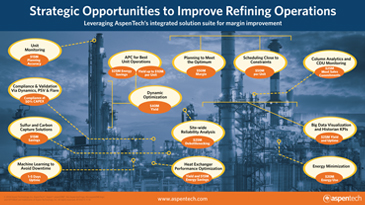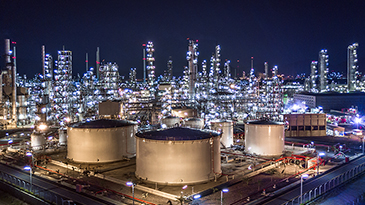Digital transformation will change refineries quickly, in ways most refining people can’t envision today! The ability to present the most important information, where they need it, in a form they readily can act on will be one of the most important outcomes. It will mean better “monetization” of data, better decision-making and more agility in a refining organization.
It is also clear that machine learning in several forms has the potential to be highly transformative, in terms of understanding patterns and trends amidst refining complexity, as well as presenting optimal outcomes to the knowledge workers in a powerful way.
In my opinion, the image of the refinery worker walking about the plant using augmented reality to view things sells the whole disruptive transformation short. It is actually the elimination of the need for people in the hazardous refinery environment that will be the expression of the transformation.
Just as oil production is looking at the operator-less offshore platform, the refinery should be able to be run better, safer, more sustainably and much more agilely through digitally transformed, autonomous software technology at the service of the knowledge worker/operator.
The future refining and petrochemical enterprise will transform rapidly. It must be agile in terms of process configurations, and must respond to a demand-driven economically unstable world.
This is the opportunity of the digital refinery.
Today
Think about today’s modern or semi-modern refinery. Distributed control stations scattered around a site have given way to more central control rooms. In some cases, a formidable array of control displays provide a battery of colored and blinking images, dense enough that no one person can take them all in at one time. And yet often they are manned by as few as one or two people surveying a complex system of units.
Separately, in an onsite or even offsite office, planners and schedulers work in their pods, planning and monitoring the flow of products, the economic lifeblood of the enterprise.
And in yet another location, often a different building, the engineering/maintenance team handles priority work orders, keeping abreast of urgent risk, bottleneck and repair situations, trying to manage the “as-built” management of change imperatives.
Tomorrow
The excitement about digital transformation stems from, on the one hand, the formidable complexity of a refining operation and, on the other hand, the promise of combining powerful data and models to unlock higher levels of performance amidst that complexity.
Several rapidly emerging technology, data and automation areas are expected to achieve disruptive improvements in business performance over the next decade. A 2017 study by the World Economic Forum identified over $1 trillion in value available to the energy industry globally through digital transformation. But the study cautioned that achieving that value across the energy supply chain involved active participation by a number of industry stakeholders and participants.
Enterprises in key energy regions have the opportunity to work together across the value chain (E&P, trading, refining, petrochemicals, retail) to achieve such a reality and economic competitive advantage against slower-moving industry players.
Global Initiatives
In the refining and petrochemical sectors specifically, several initiatives have emerged globally, called alternatively Industry 4.0, refining 4.0 and the digital refinery, among other names. The definitions and visions of different refining organizations, consultancies and technology suppliers differ. In general, though, the refining industry has been pursuing “digitalization” and automation for the past 40 years, and the current trend is merely a continuation and acceleration of that.
Current Technology Foundation
For the refining sector, this foundation of strategic technology is a critical starting point to ensure a smooth transformation and evolution. It is important to base digital transformation initiatives and plans on the existing foundation of data, technology, business and technical systems. A blueprint for incorporating current systems includes:
-
Refinery DCS and data collection. Ensure that all existing basic automation systems will fit smoothly into future initiatives.
-
Data repositories. Build on existing data historian repositories and applications and evolving to data lakes in the cloud.
-
Advanced process control. Update, expand, and enhance current APC applications to the newest generation of solutions.
-
Mass balance and movements. Integrate mass balance, inventories and movements with planning and scheduling.
-
Refinery planning. Expand the value chain personas who can access KPIs via the refinery planning system, such as trading, refinery managers and executives.
-
Refinery scheduling. Begin integrating scheduling and planning more closely to conduct look-back and look-forward analysis dynamically.
-
Unit monitoring and modeling. Apply rigorous engineering models, especially those already built for major units in some refineries, in real time, continuously calibrating them to plant conditions and using the results to advise operators and management as to operating effectiveness and trends.
-
Utilities management and optimization. Expand on the successful implementation of Aspen Utilities Planner™ online to all BPCL refineries, which optimizes use of different available utilities to both maximize sustainability and minimize costs.
-
Energy optimization. Employ so-called pinch analysis model “add-ons” to process models to identify ways to increase energy efficiency within a refinery’s process systems.
-
CAPEX evaluation and planning. Employ capital costing models together with risk analysis (Monte Carlo) models to understand most effective use of available capital during turnarounds and annual capital planning.
What You Can Do to Embark on the Journey
Digital transformation initiatives can be built on these existing technology foundations, organized along these four lines of work.
Asset reliability. Employ all available data sources and models as a basis for the application of artificial intelligence and online learning to prescriptive maintenance. Enterprise risk modeling can be employed to understand those process equipment and units that are most critical to reliability. Then machine learning can be employed to (a) provide early enough detection of future failure to be actionable and (b) provide root cause analysis of future failure, which is often attributable to process parameters.
Also, tying together advanced capital cost modeling with enterprise risk modeling can optimize CAPEX decision-making to maximize reliability per invested CAPEX dollars.
This can all be tied together effectively with the concepts of presenting the right information to the right refinery “persona” (mobile KPI data on demand in the right form) and the concept of presenting a digital twin (a digital model of the asset, both process and physical, “as operating”).
Offline optimization. Combine advanced data analytics with rigorous process modeling to tie together such crucial BPCL models as planning models, engineering system models and utility models with real-time data for validating, updating and improving the models, for making strategic optimization decisions. Again, these should be presented to different refinery personas (such as engineers, managers, operators, planners, schedulers, etc.).
Online optimization. The biggest challenge at most refineries is to bring the refinery economic plan as close to actual operations as possible, to realize the planned profit margin. Digital transformation enables the eventual tying together of all “layers” of the optimization problem, tying together the plan with the schedule, with the advanced control and real-time optimization logic.
This is achieved via a new technical breakthrough known as dynamic optimization, which continuously adjusts the optimization logic based on the plan, schedule and APC setting, taking into account dynamic plant changes.
Value chain optimization. Digital transformation also enables the extension of plant optimization across the value chain. The plant planning technology can be provided, with the right persona interface, to traders, marketers and the transport and retail chain, all in a flexible mobile enablement.
People Considerations
Digital transformation will have a sizeable impact on organizational boundaries and structure. The way people interact with strategic systems and data will change. One way to describe the possible future state at refineries is the “democratization of decision-making.”
Data and knowledge that enable workers to make better choices and decisions in their daily tasks will be driven down to the individual worker’s level. This all has major implications on how the refineries will be organized, how an individual’s work will evolve and change on a daily basis, how workers receive ongoing training and how to achieve a “high-performing” organization.
For more information on AspenTech’s solutions in this area, you can read our recent white paper, view our downstream infographic or contact me.






Leave A Comment